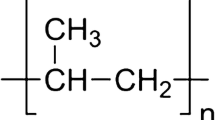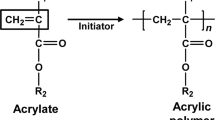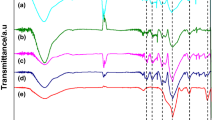Abstract
Azo compounds are widely used in polymerization as an initiator for chain polymerization reactions. Although they have excellent initiating properties, the thermal instability and associated risk of ignition and explosion cannot be ignored. This paper aimed to decode the thermal behavior and evaluation thermal hazards of two water-soluble azo initiators 2,2′-azobis(2-methylpropionamidine) dihydrochloride (AIBA) and 2,2′-azobis(2-(2-imidazoline-2-yl) propane) dihydrochloride (AIBI). Thermogravimetric analysis and adiabatic experiments were used to investigate the decomposition process of these two azos under atmospheric and adiabatic conditions. The apparent activation energy (Ea) and time to maximum rate under adiabatic conditions (TMRad) were obtained based on above experiments. Decomposition products and mechanisms of AIBA and AIBI were preliminarily studied using a thermogravimetric analyzer coupled with Fourier transform infrared spectrometer system. Results showed that most decomposition products of AIBA and AIBI still existed in the form of organic compounds under nitrogen conditions. Furthermore, the leakage of pyrolysis gas (such as ammonia) should be prevented from causing environmental pollution.














Similar content being viewed by others
Abbreviations
- A :
-
Pre-exponential factor/s–1
- C p :
-
Sample heat capacity/kJ kg–1 K–1
- C 0 :
-
Initial concentration of the reaction/mol L–1
- E a :
-
Apparent activation energy/kJ mol–1
- k :
-
Rate constant/mol1–n Ln–1 s–1
- M :
-
Mass of samples/kg
- m m :
-
Maximum self-heating rate/°C min–1
- m T :
-
Self-heating rate measured at temperature T/°C min–1
- n :
-
Reaction order
- P m :
-
Maximum pressure/bar
- P r :
-
Pressure rise rate/bar min–1
- R :
-
Molar gas constant/J kg–1 K–1
- S :
-
Wetted surface area/cm2
- SADT :
-
Self-accelerating decomposition temperature/oC
- T :
-
Reaction thermodynamic temperature/K
- T D8 :
-
Temperature at which the TMRad is 8 h/oC
- T D24 :
-
Temperature at which the TMRad is 24 h/ oC
- T end :
-
End temperature/oC
- T i :
-
Measured initial exothermic temperature/oC
- T m :
-
Maximum temperature/oC
- T NR :
-
Temperature of no return/K
- T onset :
-
Onset temperature/oC
- T peak :
-
Peak temperature/oC
- T r :
-
Self-heating rate/oC min–1
- TMR ad :
-
Time to maximum rate under adiabatic conditions/min
- t m :
-
Time at Tm
- U :
-
Heat transfer coefficient/J cm–2 K–1 s–1
- α :
-
Conversion degree
- β :
-
Heating rate/°C min–1
- \({\theta }_{{T}_{\mathrm{NR}}}\) :
-
Time constant/min
- Φ :
-
Thermal inertia
- ΔT ad :
-
Measured adiabatic temperature rise/oC
References
Nesvadba P. Radical polymerization in industry, encyclopedia of radicals in chemistry. Biol Mater. 2012. https://doi.org/10.1002/9781119953678.rad080.
Liu SH, Lu YM, Su C. Thermal hazard investigation and hazardous scenarios identification using thermal analysis coupled with numerical simulation for 2-(1-cyano-1-methylethyl)azocarboxamide. J Hazard Mater. 2020;384:121427.
Wang WH, Huang Y, Hu SY, Su W, Pan Y, Shu CM. Thermal hazards analysis for benzoyl peroxide in the presence of hexanoic acid. Process Saf Environ Prot. 2021;157:208–17. https://doi.org/10.1016/j.psep.2021.11.013.
Robert WU, Wilmington D. Aliphatic azo compounds having guanyl radicals on tertiary carbon attached to azo nitrogen: US 2599299, 1952.
Zhao YQ, Chen LJ, Nie TF, Yang SY, Bai MD. Preparation of AN/AM/IA terpolymers by mixed-solvent deposited polymerization technology. New Chem Mater. 2016;44:56–8.
Hu ZY, Cheng Y, Lei Li, Zhang QL. New method for synthesizing azobis(iso- butylamidine hydrochloride). Chem Ind Eng Prog. 2007;26:1790–4.
Liu SH, Wu T, Lu YM, Li HS. Particular thermal behavior of 2,2’-azobis(2-(2-imidazolin-2-yl)propane) dihydrochloride using DSC and STA. J Therm Anal Calorim. 2020. https://doi.org/10.1007/s10973-020-10053-x.
Liu SH, Lin WC, Hou HY, Shu CM. Comprehensive runaway kinetic analysis and validation of three azo compounds using calorimetric approach and simulation. J Loss Prev Process Ind. 2017;1–13.
Li HB, Wu W, Peng X, Wang X, Guo XY, Chen LP, Chen WH. Research on the decomposition kinetics and thermal hazards of 2, 2’-azobis (2-methylpropionamidine) dihydrochloride by experimental and simulation approach. Thermochim Acta 2020;178595.
Jiang HC, Lin WC, Hua M, Pan XH. Analysis of kinetics of thermal decomposition of melamine blended with phosphorous ionic liquid by green approach. J Therm Anal Calorim. 2018;131:2821–31.
Gao J, Chang M, Shen J. Comparison of bituminous coal apparent activation energy in different heating rates and oxygen concentrations based on thermogravimetric analysis. J Therm Anal Calorim. 2017;130:1181–9.
Wang T, Wang H, Fang W, Zhang QH, Huang XL. Certification of reference materials of Alumel, nickel and iron for Curie point. J Therm Anal Calorim. 2018;131:1979–85.
Triyono T. Correlation between preexponential factor and activation energy of isoamylalcohol hydrogenolysis on platinum catalysts. Indones J Chem. 2004;4(1):1–5.
Liu KH, Xiao Y, Zhang H, Pang P, Shu CM. Inhibiting effects of carbonised and oxidised powders treated with ionic liquids on spontaneous combustion. Process Saf Environ Prot. 2021;157:237–45. https://doi.org/10.1016/j.psep.2021.11.023.
Yang Y, Ding L, Xu L, Tsai YT. Effect of metal chloride on thermal decomposition of nitrocellulose. Case Stud Therm Eng. 2021;28:101667.
Wang CP, Deng Y, Zhang YT, Xiao Y, Deng J, Shu CM. Coal oxidation characteristics and index gases of spontaneous combustion during the heating and cooling processes. Fuel. 2022;307: 121806. https://doi.org/10.1016/j.fuel.2021.121806.
Zhang CX, Lu GB, Chen LP, Chen WH, Peng MJ, Lv JY. Two decoupling methods for non-isothermal DSC results of AIBN decomposition. J Hazard Mater. 2015;285:61–8.
Gao Z, Nakada M, Amasaki I. A consideration of errors and accuracy in the isoconversional methods. Thermochim Acta. 2001;369:137–42.
Vyazovkin SV, Lesnikovich AI. Practical application of isoconversional methods. Thermochim Acta. 1992;203:177–85.
Rao G, Feng W, Zhang J, Wang S, Chen L, Guo Z, Chen W. Simulation approach to decomposition kinetics and thermal hazards of hexamethylenetetramine. J Therm Anal Calorim. 2019;135:2447–56.
Sun Q, Lin J, Mi L, Sun JH. Assessment on thermal hazards of reactive chemicals in industry: state of the art and perspectives. Prog Energ Combust. 2020;78:100832.
Lu YM, Liu SH, Shu CM. Evaluation of thermal hazards based on thermokinetic parameters of 2-(1-cyano-1-methylethyl)azocarboxamide by ARC and DSC. J Therm Anal Calorim. 2019;138:2873–81.
Kinney GF, Graham KJ. Explosive Shocks in Air, Second Edition., Explos Shocks in Air, Second Ed. Springer Science & Business Media. California, USA. 1985.
Liu SH, Lu YM, Chiang CL, Cao CR. Determination of the thermal hazard and decomposition behaviors of 2,2’-azobis-(2, 4-dimethylvaleronitrile). Process Saf Environ Protect. 2019;131:55–62.
Liu SH, Zhan XB, Lu YM, Xu ZL, Wu T. Thermal hazard evaluation of AIBME by micro-calorimetric technique coupled with kinetic investigation. J Therm Anal Calorim. 2020;141:1443–52.
Kossoy AA, Sheinman IY. Effect of temperature gradient in sample cells of adiabatic calorimeters on data interpretation. Thermochim Acta. 2010;500:93–9.
Cao CR, Liu SH, Chi JH, Yet-Pole I, Shu CM. Using thermal analysis and kinetics calculation method to assess the thermal stability of azobisdimethylvaleronitrile. J Therm Anal Calorim. 2019;138:2853–63.
Towensend DI, Tou JC. Thermal hazard evaluation by an accelerating rate calorimeter. Thermochim Acta. 1980;1–30.
Yang XW, Zhang XY, Guo ZC, Bai WS, Hao L, Wei HY. Effects of incompatible substances on the thermal stability of dimethyl sulfoxide. Thermochim Acta. 2013;559:76–81.
Nations U. Recommendations on the Transport of Dangerous Goods: Manual of Tests and Criteria. UN: United Nations Publications. New York; Geneva; 2009.
Malow M, Michael-Schulz H, Wehrstedt KD. Evaluative comparison of two methods for SADT determination (UN H.1 and H.4). J Loss Prev Process Ind. 2010;23:740–4.
Malow M, Wehrstedt KD, Manolov M. Thermal decomposition of AIBN Part A: decomposition in real scale packages and SADT determination. Thermochim Acta. 2015;621:1–5.
Fisher HG, Goetz DD. Determination of self-accelerating decomposition temperatures using the accelerating rate calorimeter. J Loss Prev Process Ind. 1991;4:305–16.
Yang D, Koseki H, Hasegawa K. Predicting the self-accelerating decomposition temperature (SADT) of organic peroxides based on non-isothermal decomposition behavior. J Loss Prev Process Ind. 2003;16:411–6.
Reyes-Labarta JA, Marcilla A. Kinetic study of the decompositions involved in the thermal degradation of commercial azodicarbonamide. Appl Polym Sci. 2007;107:339–46.
Xu YH, Zhang T, Zhou YL, Zhou DM, Shen ZX, Lin LM. Mechanism investigation of thermal degradation of CO2-based poly (cyclohexene carbonate caprolactone). Polym Degrad Stabil. 2019;168:108957.
de Oliveira VE, Castro HV, Edwards HGM, de Oliveiraa LFC. Carotenes and carotenoids in natural biological samples: a Raman spectroscopic analysis. J Raman Spectrosc. 2010;41:642–50.
Zhang Z, Wang C, Huang G, Liu H, Yang S, Zhang A. Thermal degradation behaviors and reaction mechanism of carbon fibre-epoxy composite from hydrogen tank by TG-FTIR. J Hazard Mater. 2018;357:73–80.
Ballard L, Henderson G. Hydrogen bond energy of acetonitrile-hydrogen chloride by FTIR photometry. J Phys Chem. 1991;95:660–3.
Tsai YT, Fu T, Zhou Q. Explosion characteristics and suppression of hybrid Mg/H2 mixtures. Int J Hydrogen Energy. 2021;46(78):38934–43. https://doi.org/10.1016/j.ijhydene.2021.09.145.
Doe J, Smith S. Using absorbance to determine the concentration of CuSO4. Spectroanalysis. 2013;1:47–51.
Kim R, Pedersen S, Zewail FH. Direct femtosecond observation of the transient intermediate in the α-cleavage reaction of (CH3)2CO to 2CH3+CO: resolving the issue of concertedness. J Chem Phys. 1995;103:477–80.
Acknowledgements
The authors would like to express their sincere thanks to the Anhui Provincial Natural Science Foundation, China, under the Contract Number 1908085ME125 as well as the National Natural Science Foundation, China (52104177).
Author information
Authors and Affiliations
Contributions
R-LG: Conceptualization (lead), Methodology (lead), Writing—Original draft preparation (lead), Writing—Review & editing (lead), Formal Analysis (lead), Visualization (lead). S-HL: Writing—Review & editing (supporting), Funding Acquisition (lead), Formal Analysis (supporting), Visualization (supporting). C-MS: Writing—Reviewing & Editing (equal).
Corresponding author
Additional information
Publisher's Note
Springer Nature remains neutral with regard to jurisdictional claims in published maps and institutional affiliations.
Rights and permissions
About this article
Cite this article
Guo, RL., Liu, SH. & Shu, CM. Thermal hazard evaluation conjoined with product analysis of two water-soluble azo compounds. J Therm Anal Calorim 147, 10775–10784 (2022). https://doi.org/10.1007/s10973-022-11257-z
Received:
Accepted:
Published:
Issue Date:
DOI: https://doi.org/10.1007/s10973-022-11257-z




